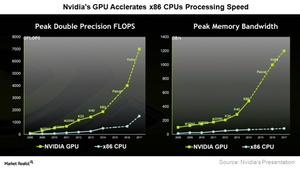What’s Nvidia’s GPU Strategy for 2017 and 2018?
Nvidia (NVDA) has reported strong growth in fiscal 2017, thanks to Pascal GPUs.
Feb. 7 2017, Updated 7:36 a.m. ET

GPUs: Nvidia’s core product
Nvidia (NVDA) has reported strong growth in fiscal 2017, thanks to Pascal GPUs (graphics processing units). But the company earns revenue from two major products: GPUs and Tegra processors, with GPU accounting for 85% of the company’s revenue.
Nvidia’s GPU revenue rose 53% YoY (year-over-year) to $1.7 billion in fiscal 3Q17 and is likely to rise to $1.8 billion in fiscal 4Q17. The company’s GPU revenue is growing faster than the overall GPU market as its GPUs are becoming the backbone for the type of computing power demanded by game developers, auto manufacturers, and data centers.
Nvidia’s position in the overall GPU market
According to Jon Peddie Research’s 3Q16 data, overall GPU shipments rose 20.4% quarter-over-quarter, whereas Nvidia’s shipments rose 39%. Nvidia’s better-than-market growth came at the cost of Advanced Micro Devices (AMD) and Intel (INTC), who lost some market share to Nvidia.
That said, the above research data only includes GPUs used in PCs, notebooks, and tablets. It excludes Nvidia’s GPUs used in data center and automotive markets, as these are new applications for the GPU that were developed by the company.
Volta GPU
Building on its strengths, Nvidia is set to launch its next-generation Volta GPU, which would succeed Pascal. The Volta architecture is expected to go beyond node shrinking and bring a significant improvement in design compared to Pascal.
The Volta is expected to feature an SM (streaming multiprocessor) that would improve power efficiency and performance regardless of the transistor size. Instead of 4K, the Volta GPU is expected to support dual 8K HDR (high dynamic range) video recording. Nvidia stated that the Volta GPU would be smaller than Pascal and come with NVLink 2.0 interconnect that will communicate at 25 Gbps (gigabytes per second).
Notably, Volta GPU is likely to be built on TSMC’s (TSM) 10 nm (nanometer) node, which the foundry claims would bring 20% performance improvement from the 16 nm process.
When will Volta GPU hit the market?
Nvidia plans to unveil Volta GPU at its GTC (GPU Technology Conference) in May 2017. It has already unveiled its Volta-powered Xavier SoC (system on chip) for automotive in September 2016. According to tech experts, the company is expected to launch its Volta GPU for supercomputers in 2017 and Volta GPU for gaming in 2018.
Nvidia’s Volta GPU would compete with Intel and AMD’s processors for the next two years. The Volta Tesla GPU would compete with Intel’s Knights Mill Xeon Phi processor and Knights Hill processor for deep learning. Volta GPUs would also compete with AMD’s Vega GPUs for gaming and deep learning.
